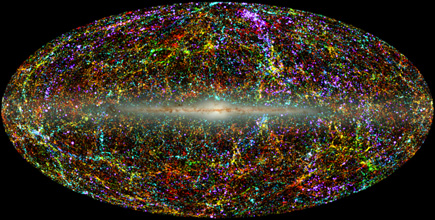2MASS Galaxy Redshift Catalog (XSCz)

2MASS Galaxy Redshift Catalog (XSCz) |

|
Spectroscopic velocities are biased to cluster galaxies with infall space motions that are primarily along the line of sight. The end result for a cluster is a set of redshifts that are enhanced along the radial direction and suppressed (or more accurately, neutral) along the perpendicular direction. The cluster thus appears "cigar" shaped, seemingly stretched along the radial direction (for a better explanation of the 'caustic' shape, see Liz Praton's Infall Artifact article). The higher the velocity dispersion, the more stretched the cluster appears. As legend has it, Brent Tully referred to these artifacts as "fingers of god", a colorful description of how the stretched cluster seemed to point back to the Earth, as if they were a big god-like finger. Perhaps the most famous finger is seen in the CfA Great Wall pie-diagram produced by Huchra & Gellar, showing the radial stretching of the Coma Cluster that points back to the observer, perpendicular to a coherent string of clusters that is collectively known as the Great Wall.
For the purpose of improving the 4-D visualization, the radial velocity artifacts are 'statistically corrected' for a set of well-defined galaxy clusters. The method does not attempt to derive the actual Z-location for a given cluster galaxy, but instead derive a statistically accurate representation for the cluster. Knowing the cluster kinematics, physical size, and radial density distribution, it is possible to modify the Z locations so that the XYZ locations of cluster galaxies collectively portray the cluster parameters of dispersion, size and distribution. We make the assumption that the cluster radial size is between 1 and 2 Mpc, depending on the number of cluster galaxies (i.e., total mass) and that the galaxies are radially gaussian distributed (although the density distribution may be more accurately described with a R1/4 or even isothermal King profile, a gaussian is adequate for our means). The spatial location and velocity dispersion comes from cluster catalog extracted from NED, ZCAT and the Abell catalog. Clusters that do not have catalogued dispersions are assumed to have a value of 1000 km/s. XSCz cluster candidates are identified by their equatorial coordinates and redshifts such that they fall within the expected dispersion of the catalogued galaxy cluster. Candidates that are located behind the cluster center (i.e., redshifted relative to cluster center) are relocated to Z-locations behind the cluster center that are determined using a monte-carlo gaussian distribution appropriate to the cluster. Likewise, galaxies in front of the cluster ("blue-shifted") are gaussian distributed in front of the cluster. For galaxies with zero redshift relative to the center (i.e., their peculiar motion is perpendicular to the radial direction), they are gaussian distributed along the perpendicular direction. Galaxies with kinematics between line-of-sight and across-sight are correspondingly treated to fill the cluster gaussian sphere. In this way, the cigar-shaped cluster is reshaped into a spherical-shaped cluster with a gaussian distribution. For isolated clusters, this is a relatively straight-forward process (see the Coma Cluster example below). Complications arise for clusters that are in close proximity, potentially mixing populations as some galaxies may be 'pulled' into the wrong cluster (e.g., see the Hercules Cluster example below).
The table below illustrates the performance of the finger-of-god correction process for a few prominent clusters (both isolated and complex).
Last updated by T. Jarrett on Dec 9, 2006